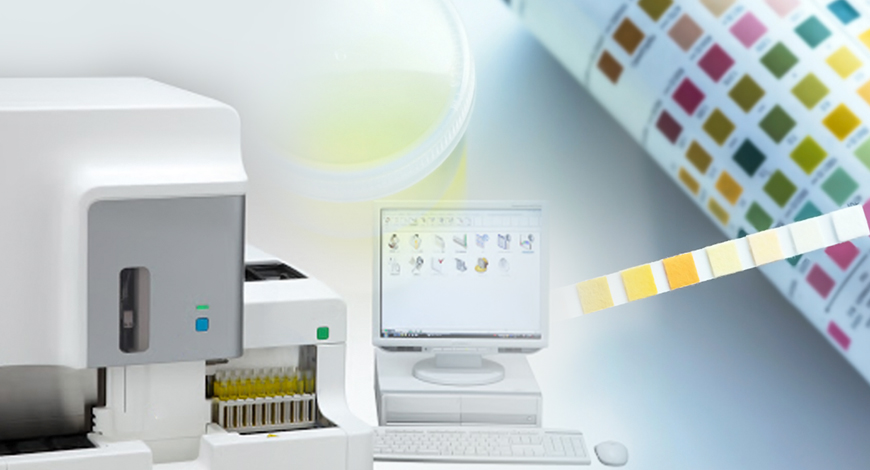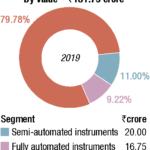IVD
Have come far, yet miles to go in urinalysis

Analytical variation has been greatly reduced in this frontline diagnostic tool; yet more efforts need to be focused on the pre-analytical phase.
 Urinalysis is a major diagnostic screening test in the clinical laboratory, with an important role in diagnosing and monitoring nephrological and urological conditions. Laboratory medicine began with the analysis of human urine, which was called uroscopy till the 17th century and today is termed as urinalysis. Out of all the analyses performed in the clinical laboratory the urinalysis has one very distinct advantage – it is completely non-invasive!
Urinalysis is a major diagnostic screening test in the clinical laboratory, with an important role in diagnosing and monitoring nephrological and urological conditions. Laboratory medicine began with the analysis of human urine, which was called uroscopy till the 17th century and today is termed as urinalysis. Out of all the analyses performed in the clinical laboratory the urinalysis has one very distinct advantage – it is completely non-invasive!
Until the last decade, semi/automated urine chemistry and manual microscopic urine sediment analysis was the only available and widely accepted urinalysis methodology in India. However, manual microscopic sediment examination is labor-intensive, time-consuming, and lacks standardization in moderate and high-volume laboratories. In addition to these limitations, one important factor is centrifugation loss (unsettled urine particles thrown out in supernatant after centrifugation), which is ignored in the manual sediment analysis process. Still, this methodology is practiced in more than 90 percent of laboratories in India.
Automated technologies and informatics have greatly reduced the labor intensity of urinalysis, and have paved the way for significant progress in urinalysis with better accuracy and precision.
The current challenges facing urinalysis may be overcome with the development of high throughput integrated sensing systems, and point of care (PoC) devices for personalized medicine. Measurements right at the site of collection reduces the need for sample storage and transportation for testing and may provide more reliable results for patients sending samples far from testing facilities. The results may be available shortly after sample collection enabling more rapid response to results. Additionally, samples may be screened at the site of collection to determine if a more detailed analysis is required to reduce the number of samples sent to testing facilities, reducing the demand and cost of urinalysis testing. By screening for infections and monitoring chronic diseases before they become symptomatic the demand on testing labs may be reduced and potential for early intervention may be improved. The contents of urine samples are highly variable, between individuals and for a given individual over time. Remotely monitoring contents of urine samples over time provides an opportunity to establish normal baselines for individual users. Trends in results over time may be used to identify the development of health challenges before symptoms appear. Integration of new functional components in microfluidic devices such as pumps, mixers, valves, filters may be used to enable automated sample handling, processing, analysis, and disposal, in order to overcome the need for trained technicians to perform analysis.
Continuing development of microfluidic detection methods for the analysis of urine will lead to reliable sensing modules for many diagnostic indicators. Many of these sensing modules may be integrated in a single device to allow for the simultaneous detection of several analytes. The development of new microfluidic microscopies and lens-less imaging techniques provide an opportunity to dramatically reduce the size and cost of microscopic examination of samples. High throughput microfluidic microscopy has the potential to detect infections with low concentrations of bacteria without long incubation times, significantly reducing the time for test results.
Point-of-care diagnostic devices may be developed that are capable of continuously monitoring urine samples on an ongoing basis, enabling the early detection of diseases and the monitoring of chronic disease. These monitoring devices may be portable units to be deployed, or permanently installed in the home such as smart toilets. Several parameters can be measured from the toilet itself such as the frequency of toilet use, and uroflowmetry when using the toilet which may provide an indication of a patient’s response to medications such as diuretics.
Most of the new PoC urinalysis devices are based on reagent strip readers. The reagent strip design has inspired several chip-based sensors employing a wide range of detection methods. It is not recommended that one should simply develop more test strips to cover a wider range of analytes or concentrations due to the complex nature of the sample and the interactions between different components. Making a device that incorporates redundancy by measuring several parameters using independent methods may provide more reliable information about sample contents. Not all of the methods used in urinalysis testing needs to be translated to microfluidic devices. There are several methods that can be used to detect the presence of bacterial infection. More extensive testing can be performed in lab settings to identify the infecting organism and to determine the effective antibiotic treatment for the infection.
As the methods used to perform urinalysis continue to translate to portable PoC monitoring devices results can be obtained directly from the site of collection, rapidly, and on a continuing basis. The integration of urinalysis devices into smart toilets also allows monitoring of the frequency of urination and volume of urine. This provides an opportunity to detect developing illnesses at an early stage, as well as to monitor ongoing chronic illnesses and response to treatment. The personalized urinalysis may be used to reduce the number of samples sent to large testing facilities to save time and cost by prescreening samples. With the development of lensless imaging devices automated point-of-care microscopy may also be conducted on urine samples for direct detection of sediment and infectious particles. These sensing strategies may also be applied to alternative remote fluid monitoring applications such as analysis of saliva, environmental water quality monitoring, and process control.
Need to improve pre-analytical phase
Over the past two decades, automated urinalysis has undergone remarkable technical progress. Both microscopy- and flow cytometric-based instruments generate reliable results that are clinically useful, and automated test strip reading provides added value. Additional integration of existing technologies may further reduce turn-around times.
In the meantime, the consolidation of laboratories has led to a reduction in the number of laboratories and has thereby increased the physical distance between patient and laboratory; this trend creates a major pre-analytical challenge. Despite improvements in standardization, most of errors in urinalysis occur outside of the analytical phase; pre-analytical steps, in particular, are much more vulnerable. As analytical variation has been greatly reduced, more efforts need to be focused on the pre-analytical phase.












